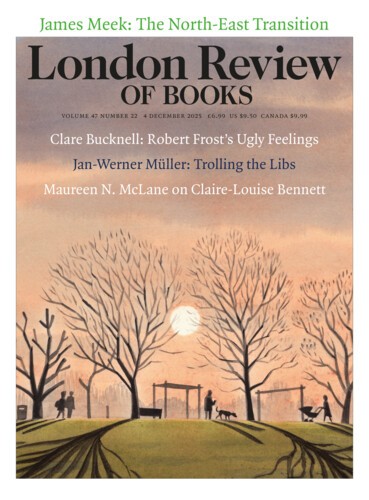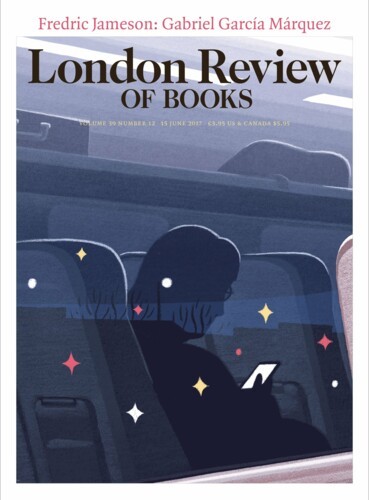The statistics on Stateway Gardens were grim. In 1989, average per capita annual income in the 1648 apartments was $1650, making it the poorest neighbourhood in the United States. Figures for murder and drug crime were also high. The Chicago Housing Authority had erected the eight high-rises in the late 1950s to replace the South Side slums that African Americans arriving in the city had long made their first base, but afterwards the agency’s attention drifted, security lapsed, services and surfaces were no longer maintained. Jasmon Drain’s short stories about growing up there in the 1980s note the ‘scant brown grass’ and feature a kid dodging the hustlers whose mother tells him: ‘Life isn’t about fun. It’s about money.’
Lush green grass abounds in Many Mansions, the ten-foot-wide vision of the housing project that Kerry James Marshall painted in 1994 and which currently hangs in The Histories, the Royal Academy’s vast survey of his work (until 18 January). Candy-coloured blooms sprout and bluebirds fly. Upfront before the trim topiary and the flowerbed’s dainty hoops, we meet three gardeners who tend the communal space dressed in spotless Sunday best. The soft toys in turquoise and cerise in their cellophane wraps: Easter baskets for their children, we guess, guessing also that this is paradise. This is the utopia projected by Chicago progressives, the lost land glimpsed in the recollections of a visitor to the newbuild quoted in the Chicago Tribune in 1958: ‘You could sit on the grass and just enjoy yourself.’ Marshall’s fantasia allows us to think: those lawns might not yet be lost; their seeds lie merely dormant in the resilience of the buildings’ 3000-odd inhabitants. (Many of whom objected when the high-rises were finally demolished in 2007.)
A ribbon dangled over the young fathers teasingly adapts Jesus’s words to read: ‘In my Mother’s house there are many mansions.’ The insertion of this heraldic device suggests an aspiration: Marshall would like his picture to come across not so much as a gallery artwork, but as a banner, an assertion of community solidarity to be marched down the street, held high on poles attached to the grommets that punctuate the canvas edges. Affirmative depiction, we are to believe, is this artist’s agenda. When it comes to the Black American experience, switch round the story!
But nothing is quite that simple. It is more as if Marshall, standing in a studio near Stateway Gardens and the Chicago Loop, was dreaming a dream about dreaming the dream. As of 1994 he was six years settled into the city after a Los Angeles education and a more recent experience of New York: a 39-year-old who had grown up in housing comparable to the Gardens, who had become thoroughly familiar with the era’s American art debates but who was not yet a recognised voice in the arena. The whims and moues of 1990s discourse – its fondness for ‘traces’ and ‘aporias’, its prevailing scepticism – tinge Many Mansions, tangling with Marshall’s aim of addressing a specific social history. Blanked out, non-signifying signs: collage-like disjunctures; mazy, curling brush trails heading nowhere; wanton drips and splats: all this is not so far from what David Salle, the field leader of ‘postmodern’ painting, was then up to. One form of art-world good behaviour plays off against another: the springy triangular torque generated by the gardeners’ poses is a lesson learned from Old Master figure painting. We deduce that for Marshall, the art gallery in fact took precedence over the street. ‘I wanted to make work that was about something,’ he has been quoted as saying. Yes, but only somewhat. You could call his canvas meaningfulesque.
Take your stand aesthetically while reaching out politically: it’s a sane, even a standard posture for painters. The Royal Academy exhibition surveys an artistic project that was starting to take firm shape in the early 1990s – Many Mansions was followed by further billboard-sized takes on accommodation, education and leisure – and which Marshall has energetically expanded, to great acclaim, to the present. This ‘project’ (he uses the term for a body of work that demonstrates great consistency of purpose) has a moral aspect: here is an art about and on behalf of his community, making more visible its hitherto underrepresented histories. It supplants statistics with experience. The instincts driving it are constructive rather than critical: ‘My work is not an argument against anything; it is an argument for … something else.’
But there’s another angle to that claim. ‘It’s not a challenge to anything. Nobody really goes to art museums to learn how they should live.’ Accordingly, the paintings rarely moralise. Studious, ironical, here absurdist, there sombre, Marshall likes to dwell on riddling content. A recent triptych features 19th-century Africans trading one another to slavers; a large picture of a Black cop, accorded full dignity, appeared when ‘Defund the Police’ was the Black Lives Matter demand; Nat Turner, leader of an 1831 slave revolt in Virginia, is shown, axe in hand, before his master’s severed head. (This formidable panel stands out among works that otherwise hold violent or erotic content at one remove.) Nobody going to the Royal Academy is told how they should live. Stop in your tracks, look at me, keep on looking: those are the default demands, the age-old agendas to expect from figuration.
As with old icons, the eyes dominate the asking. The quizzical quality of gaze we encounter from the gardener with the rake reappears whether Marshall is picturing individuals from history or contemporary urban ambiences. It catalyses De Style (1993), the archly titled barbershop scene that became his calling-card image. Barber, customer and two über-stylists with wild hairdos stare out from a salon interior presented with a sharp, Mondrian-like orthogonality. Nikita Sena Quarshie in the show catalogue compares the self-possession with which these men are brimming to ‘the itutu or mystic coolness of the Yoruba’ – a compliment to Marshall, who likes to point upwards to West African forms of thought. For Greg Tate, De Style’s males and their female analogues in School of Beauty, School of Culture (2012) were exponents of ‘the very Black, very social art of being seen’. This white viewer would qualify that: their seeing feels active rather than passive. They know who they are; can he say the same? It is he who finds himself viewed. ‘Not a challenge,’ you say. Are you sure?
The forcefulness extends further. Marshall’s acrylics are not actually Mondrian-style flat, still less do they open up atmospheric depths. Instead, his project projects. What he depicts juts out at you, an effect often compounded by glued-on strips of glitter. Instead of continuous modelling, sequences of tone have been picked apart cleanly and laid down opaquely. Each object stands entirely distinct, a confine with its own often zinging colour identity. The severity can be bracing. Espressos for the eyes: I relished the way, as I roved from one scene to another, that a baby’s dummy, a dozy mastiff, a bunch of keys and a skull were analysed and reassembled as if by a master horologist. Marshall’s versatile toolkit is laid out in the show’s opening gallery, where the brushwork ranges from grisaille to finicky patterning to passages of free-form goofing. The display is of artworks that thematise art: a self-referential scene of a painter’s studio, for instance, that further references antecedent scenes by Vermeer, Courbet and Picasso.
They’re flash, they’re witty and in a sense inturned: ‘up themselves’, in the common accusation of outsiders to the art world. And yet the aestheticisation is barbed. For its pivotal tactic, Marshall chooses to render the skins of his protagonists with black paint. Or more exactly, with a plurality of pigments, working warm ivory black against cool lamp black and heavy Mars black to lend the bodies a certain degree of volume. The gambit takes ethnic identity at its word – ‘Black, you said?’ – and converts that word into concrete visual experience. It stirs up thoughts that don’t settle. Here’s discursive jujitsu, a categorisation flipped backwards. Here’s an artistic contender intent to brand his act. Here’s a fresh and unfamiliar offer to the retina. You’re kept alert, wondering how best to respond.
Marshall’s steely intelligence meets no match. In a preface to the catalogue he is questioned by Benjamin Buchloh, a veteran of 20th-century art studies. Buchloh, predisposed to pessimism about traditional media, frets that ‘refined pictorial conception and painterly execution maintain the hierarchical order of skills.’ Marshall affably flattens him with a succession of demurrals: the communal good, for his purposes, is best served by delivering what’s ‘worth looking at’, by ‘remarkable things’. The exhibition’s curator, Mark Godfrey, having gone through a similar academic formation, confesses that a confrontation with Marshall’s School of Beauty ‘challenged my deeply held convictions about the illegitimacy of contemporary figurative painting’. His reservations came to seem ‘irrelevant in front of a painting of such care, ambition and possibility’. Some of us outside curatorial circles might smile at this conversion, confident that those qualities never left the medium. But on behalf of that community, Godfrey here marks the historical point at which a supposed endgame ended.
Godfrey is an engaging writer, as warm-hearted as his subject is clear-headed. Is he a wise curator? The Royal Academy’s first-floor spaces are so vast that no single artist can fill them all happily. Marshall’s steeliness becomes chill and unyielding in a gallery devoted to his sardonic takes on Rococo pastoral painting, which he calls ‘Vignettes’. Another series, ‘Souvenirs’, wan interiors decked with names and faces from Black history, comes across as little more than a dry roll-call of the honoured dead. At such points in the display my thoughts turned to another show, staged earlier this year at the Barbican. The brevity of Noah Davis’s career – he was only 32 when he died in 2015 – meant that, unlike Marshall, he was hardly positioned to change the course of art history. Indeed, Davis took example from Marshall, his senior in Black figuration, and in his explicit dependence on snapshots was arguably a slighter inventor. Marshall, by contrast, so thoroughly transmutes his imagery that its points of reference hardly ever feel photographic. And yet what I missed at the Royal Academy was the exploratory, self-surprising, mystery-accepting manner with which Davis worked his washes of oil paint. I fell in love with his poetry in the medium. With Marshall’s acrylic prose, I reason, react, smile wryly and admire: it is as if no more is asked of me.
With this exception. The most powerful visual invitation in the show comes from its least reproducible item, a landscape-format panel from 2003, measuring nine feet by six, that is entirely dark. Stay with it and its darknesses begin to disentangle. For once, you are plunging in, rather than being buffeted by jagged lemon yellows, blasts of scarlet, rock-rigid cerulean skies. Via the slight differences between one absorptive pigment and the next, an interior is gradually revealed: a bedroom in the small hours. Dark-adapting your eyes, you identify two chests of drawers, three lampshades, a revolutionary flag, a book by the bedside telephone; amid them, a woman’s back dimly rising from a shadowy duvet, and finally the sleeper she needs to alert. What’s woken her? The cops are at the door, goes the backstory; they’re about to shoot her boyfriend. It’s 1969. He’s Fred Hampton, a 21-year-old Chicago Black Panthers leader. And she will never rouse him, because the FBI, resolved to dispatch this clean-handed idealist, has paid a Judas brother to slip him barbiturates. The facts of the atrocity dangle over the great cavity in the gallery wall and stay suspended: we sink down towards Hampton’s unconsciousness, the nothing that is so far happening. Marshall’s masterpiece is called Black Painting.
Send Letters To:
The Editor
London Review of Books,
28 Little Russell Street
London, WC1A 2HN
letters@lrb.co.uk
Please include name, address, and a telephone number.



